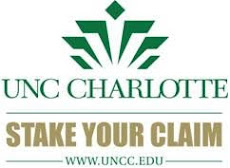By Wills Citty
Deep
underground in a basement auditorium, a high schooler is teaching about nanoparticles.
It’s the end of a hot summer spent in cool laboratories for the fortunate juniors
and seniors chosen for the research experience at UNC Charlotte. Delivering
their presentations marks the culmination of more than a month of study for the
six high school students, who were paired with professors to work on complex
scientific questions.
The
high schoolers were part of a paid internship program offered by UNC
Charlotte’s Center for Science, Technology, Engineering and Mathematics
Education (CSTEM); it provided them the
chance to perform real science on a college campus.
 |
| UNC Charlotte faculty researchers worked with high school interns in a summer research program. |
Dawson
Hancock, associate dean for research and graduate studies in the College of
Education, said the quality of the students’ research was remarkable. “I was
extremely impressed with the methodology and the soundness thereof, the detailed
analyses, and the eloquence of the presentations was outstanding.”
The
students’ investigations covered a range of scientific spheres. One looked at
the possibility of making solar panels more efficient using microscopic silver
particles. Another considered ways to improve photodynamic therapy — killing
cancer cells with light.
Local
student David Mack spent the summer researching how to use Doppler radar to
help robots see and navigate better; his presentation, under the supervision of
James Conrad, professor of electrical and computer engineering, was entitled
“Using Robots and Range Finder Data to Create Navigational Maps.” For Mack, the
research was the continuation of years of personal interest.
“Creating
information gathering technology has interested me for a long time, since I was
five as a matter of fact, and I thought that this experience would be a good
opportunity to try my hand at it,” he said.
Victor
Mack is the director of the Office of Educational
Outreach at UNC Charlotte, and David Mack’s father. The elder Mack led the
program from its inception on campus in 1998 through 2006. He said watching his
son benefit from the experience was meaningful.
“I'm
glad to see the program continue and be supported by the college,” said
Mack. “For me, I feel as if I have come full circle. Rare are the
opportunities to see our children benefit directly from our labor and excel. I'm
extremely proud and thankful.”
The
younger Mack said navigating the fast-paced environment of a university
laboratory was a new experience, but that his supervising professor was
receptive to questions and provided the needed guidance along the way.
A
parent who attended the symposium said her son’s “personality changed completely”
over the course of the six-week program, and that the experience went a long
way to establishing work ethic.
The
program was initially created through a National Science Foundation grant as
part of a statewide program. That funding dried up, and UNC Charlotte is the
only remaining site of the original six that maintains the program;
discretionary funding from CSTEM has been used to keep it afloat.
Hancock
said the summer research program is in sync with CSTEM’s overarching goals: to
heighten the visibility and salience of these topics in the public
consciousness.
“The
centers were created because STEM wasn’t getting the level of attention it
needed,” stated Hancock. “We recognized that in the global economy, the college
needed to develop students’ talents and interests at a young age.”
Along
with the summer research experience, CSTEM operates a pre-college program that
helps prepare students from six nearby counties for math, science and
engineering-based careers. The program is affiliated with the North
Carolina Mathematics and Science Education Network and coordinated on
campus by Shagufta Raja, a pre-college coordinator for CSTEM. It
consists of a 12-week Saturday academy that meets during the school year, as
well a summer scholars program separate from the more intensive summer research
experience.
Hancock,
who described these programs as a “win-win,” said, “Participants gain exposure
to a university stetting, work with faculty in that environment and engage in
depth in areas of STEM in which they are particularly interested. The
University gains the benefit of exposing students to our campus, so they can
hopefully develop a better understanding of what we have to offer, and maybe
one day even become 49ers themselves.”
Concluding
presentations by the other high school students were:
· Kartheek Batchu’s ″Effect
of Nanoparticle Sized Silver Paste on Contact Resistance,” supervised by
Abasifreke Ebong, professor of electrical and computer engineering.
· Ethan Wickliff’s ″Screen-printed
Solar cell Efficiency Improvement Though use of Appropriate Ag Paste,”
supervised by Ebong
· Bhavana Ambil’s ″Effect
of ADP on Actomyosin Dissociation,” supervised by Yuri Nesmelov, an assistant
professor in the Department of Physics and Optical Science
· Dean Tran’s ″The Use
of Radio Waves in Determining Distances,” supervised by Conrad
· Jared Johnson’s ″Improving
Skin Permeation for Photodynamic Therapy,” supervised by Juan Vivero-Escoto,
assistant professor of chemistry.
# # # #
#
